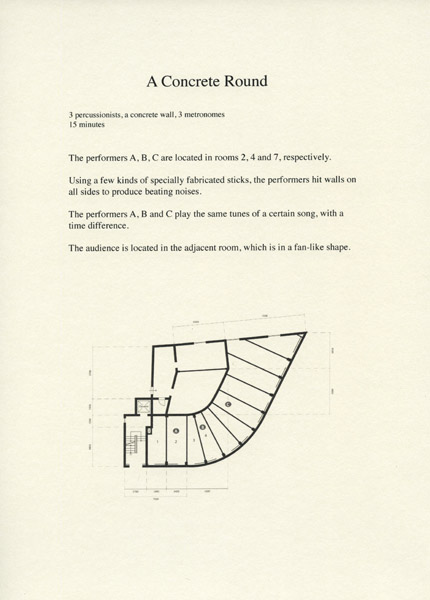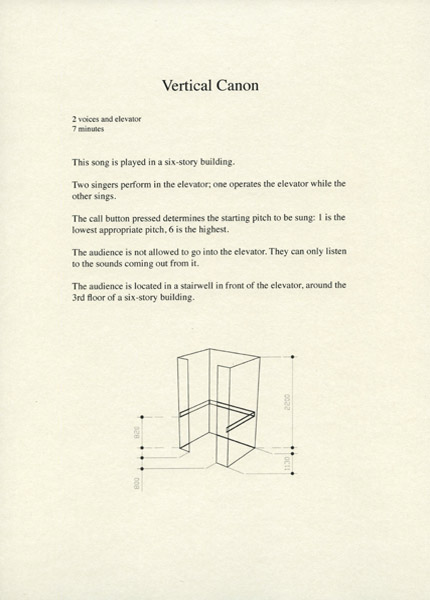Bespoke Wallpaper Music
2014
Sound performance series
Percussionists, voice performers, metronomes, walkie-talkies, ladders
60 minutes
This sound performance was held at the Solomon Building, located in the heart of Hwanghak-dong Market, a vast second-hand market in Seoul. The market, often referred to as “The Last Market,” is a place where items that have been used to their fullest flow in before being discarded. The fan-shaped Solomon Building stands tall in one of the market’s alleys. Upon entering, visitors experience an unexpected visual blockage, in stark contrast to the eye-catching surroundings. As one explores the interior of the building, small, hidden rooms stacked behind the walls are discovered. These rooms were once used as small shops during the market’s heyday, but today they lie quietly, overlapped. The discovery of these hidden rooms stimulated my imagination and made me rethink other unnoticed aspects of the building, such as an elevator moving behind a static door or a veranda wrapping around the building behind a curved wall.
The first floor is lined with numerous small rooms arranged in a pie-slice pattern, hidden behind a curved wall. A small elevator moves intermittently between the first and sixth floors behind a door and a wall. The sixth floor contains five additional rooms surrounding a large central space. In such spaces, where visibility is obstructed, aural experiences take on a new identity, allowing the space to be sensed in an entirely different way. From previous works, such as Room 402, I have learned that sound can reveal the physicality and placeness of visually featureless or entirely invisible spaces—what I refer to as aural spaces. I conceived this sound performance, centered around voices and walls, by tapping into the potential of the Solomon Building as a powerful aural space.
During the performance, the performers conceal themselves in spaces where they cannot see or touch each other. They continue their performances based on the faint sounds of other performers and the conductor’s remote signals. The audience, likewise, cannot see the performers. They are left to track the performers’ positions or imagine the spaces they occupy, interpreting them solely through sound.
(KR)
2014
Sound performance series
Percussionists, voice performers, metronomes, walkie-talkies, ladders
60 minutes
This sound performance was held at the Solomon Building, located in the heart of Hwanghak-dong Market, a vast second-hand market in Seoul. The market, often referred to as “The Last Market,” is a place where items that have been used to their fullest flow in before being discarded. The fan-shaped Solomon Building stands tall in one of the market’s alleys. Upon entering, visitors experience an unexpected visual blockage, in stark contrast to the eye-catching surroundings. As one explores the interior of the building, small, hidden rooms stacked behind the walls are discovered. These rooms were once used as small shops during the market’s heyday, but today they lie quietly, overlapped. The discovery of these hidden rooms stimulated my imagination and made me rethink other unnoticed aspects of the building, such as an elevator moving behind a static door or a veranda wrapping around the building behind a curved wall.
The first floor is lined with numerous small rooms arranged in a pie-slice pattern, hidden behind a curved wall. A small elevator moves intermittently between the first and sixth floors behind a door and a wall. The sixth floor contains five additional rooms surrounding a large central space. In such spaces, where visibility is obstructed, aural experiences take on a new identity, allowing the space to be sensed in an entirely different way. From previous works, such as Room 402, I have learned that sound can reveal the physicality and placeness of visually featureless or entirely invisible spaces—what I refer to as aural spaces. I conceived this sound performance, centered around voices and walls, by tapping into the potential of the Solomon Building as a powerful aural space.
During the performance, the performers conceal themselves in spaces where they cannot see or touch each other. They continue their performances based on the faint sounds of other performers and the conductor’s remote signals. The audience, likewise, cannot see the performers. They are left to track the performers’ positions or imagine the spaces they occupy, interpreting them solely through sound.
(KR)







#1-3
Performance view of Bespoke Wallpaper Music (Solomon Building+Cake Gallery, Seoul, 2014). Video still: Mee Jee Lee.
#4
Performance view of Bespoke Wallpaper Music (Solomon Building+Cake Gallery, Seoul, 2014). Photo: Jong Hyun Seo.
#5-7
The opening pages of each score.
5 min video documentation